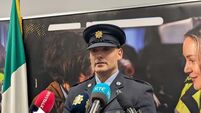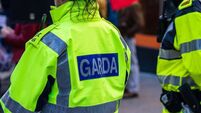Prosecution: O’Reilly 'only person with motive'
Prosecution counsel in the Rachel O’Reilly murder trial told the jury today that the only person with a motive was Joe O’Reilly.
Mr Dominic McGinn BL was closing the case for the prosecution on the 19th day of the trial of Mr O'Reilly (aged 35) of Lambay View, Baldarragh, Naul, Co Dublin who has pleaded not guilty to murdering his 30-year-old wife and mother of two, Rachel O'Reilly, at the family home on October 4, 2004.
McGinn said the jury “up until now have had a passive observing role”.
“Now your role rises to the top. Your role is the most important role, to decide whether Joe O’Reilly is guilty or not guilty. The evidence is in your domain, your province.”
He told them that while he was going to try to persuade them that there was “only one inescapable conclusion” to the case, they did not have to agree with the comments he was going to make and that they would take the rules of law from the judge.
“If you come to a conclusion on the evidence, that is final,” he said. “The duty of the prosecution is to prove guilt beyond reasonable doubt.”
But he told them that if they had any reasonable doubt then they must find him not guilty.
He explained that the phrase “beyond a reasonable doubt” has perhaps lost some of its value because of its presence in films and TV, but said that it was a rule of law which they had to abide by.
However, he said: “You don’t have mathematical certainty in human affairs.”
He said that a niggle or something at the back of your mind is not reasonable doubt.
He added: “My suggestion is that there is none.”
He reminded them that they were to try the case only on the evidence they heard in court, and not what they might have heard or read elsewhere.
He said that while it canot have been easy for Rachel O’Reilly’s family to sit here and listen to the evidence or for Joe O’Reilly and his family, they should not decide the case on emotion sympathy or prejudice.
“You have to assess the evidence in that cold, analytical manner,” he said.
In talking to them about the case, he said it was probably best he started with the evidence which was uncontested.
He told them Rachel O’Reilly was found dead by her mother at their home in the Naul and that she was last seen driving children to school.
“The assumption is that she must have come straight home,” he said.
He said CCTV footage at Murphy’s Quarry shows her silver/ grey Renault Scenic leaving at 9.03am and coming back to the house again at 9.41am.
He said there was “no dispute” as to the cause of her death.
He asked them to look at the photo of the O’Reilly home which showed a large amount of blood there.
“The first thing you can be sure of is Rachael O’Reilly was murdered,” he said.
He reminded them of the words of Rachel’s mother, Rose Callaly, who said: “As soon as I saw her I knew she was dead and I knew she had been murdered.”
But he said there were other undeniable facts, including the time of the attack.
He said that while Prof Cassidy could not pinpoint the time of death, as death may not have been instantaneous, the time of the attack had to have been fairly soon after Rachael came home.
He said that this must be so because the car keys were underneath her body indicating she had just arrived home.
“The real question is who did it,” he said.
He said that because there were drawers was pulled out and several DVDs strewn across the floor, the first assumption was that it was a random killing by a burglar
However, he urged them to consider whether this “seems likely or possible”.
“The evidence shows it to be impossible,” he said.
He reminded them about the amount of blood that was there.
He said Dr Daly told them there was so much blood she could not see the injuries.
She did a blood pattern analysis, which showed she was beaten while lying on the ground.
He said that, given the amount of blood, whoever attacked her would be covered in blood.
“If attacker had got up and walked out through the hallway to the decking, surely you’d expect traces of it to be elsewhere,” he added.
Referring to the blood that was on the washing machine which was found to belong to that of her brother, Thomas Lowe, he said there was an assumption on the part of the defence that he must be the killer.
However, he added: “This is pure speculation that doesn’t stand up to scrutiny.”
He explained that if brother had been the attacker, then why was there none of his blood at the scene of attack? He said the blood on the washing machine indicates that if he had been the killer, that he did not try to clean up after himself.
“This is speculation and it is not allowed,” he said.
Furthermore, he added that Mr Lowe admitted to gardaí that it was his blood and said that Mr O’Reilly himself also told gardaí that Mr Lowe often did work around the house.
“The only way for the killer to get out of the house without leaving a trail of blood would be to have a wash,” he said.
Mr McGinn then asked the jury to consider what a "typical burglar" does when he breaks into his house.
“He doesn’t wait to encounter someone and if they do they panic,” he said. “The actions of this killer were far from someone in panic. He stopped and had a wash so as to have no drips. It wasn’t someone who happened to be there by chance.”
“The thing to do would be to get out. He wouldn’t hang around and have a wash. Perhaps he was a calm burglar. But this doesn’t fit in either.”
“Even if he had been watching things for weeks surely he’d finish the burglary. Why wouldn’t he finish the burglary? There was a handbag with €450 in cash and there was a plastic container in the kitchen with €860 in it.”
“Instead, the burglar leaves with a camera and some of Rachael’s jewellery. There was no blood on this.”
He also asked them to consider why the burglar would then leave the stolen goods in a ditch 200 yards form the house.
“The reality is it wasn’t a burglary or random attack,” he said. “The evidence points to someone who knew they wouldn’t be disturbed.
“It was someone who tried to make it look like a burglary.”
He reminded the jury that Mr O’Reilly told a friend that he was convinced the killer knew Rachael O’Reilly.
Mr McGinn said that if so, the killer must have had a reason and asked them to consider who had a motive or reason to kill her.
He reminded them that Mr O’Reilly told gardaí about a number of people who he had sacked and their neighbours, with whom Rachel had talked to about the land.
He also reminded them that Rachel’s natural family gave evidence that they got on well with her.
Mr McGinn then reminded them about the O’Reilly’s home insurance policy, from which Rachael death meant Joe stood to gain financially.
He then said Mr O’Reilly was also in love with another woman and that he tried to minimise that in the evidence.
He said Nikki Pelley, the woman with whom he was having the affair, gave evidence of Mr O’Reilly asking her to play down the relationship as it would be seen as a motive to kill Rachael.
Mr McGinn then moved on to the texts. He said the tone of the messages in the days before the killing were very clear in their feelings.
He reminded the jury that in one of the texts to Ms Pelley, he referred to his children as “our” boy.
He told the jury that while Mr O’Reilly was worried that after he separated from Rachel, he might lose custody of the children, “that alone is not a reason to kill your wife”.
He said that there are many men who want to leave their wives but do not want to kill them.
“But that’s when things take a darker turn,” he added.
Referring to the emails sent by Joe to his sister, he said they give “a true account” of Mr O’Reilly’s feelings towards Rachel and are not in keeping with the “white-washed” version he gave to gardaí.
He said his “real state of mind” was evident from those e-mails in which he referred to himself as “Mr Weekend Custody”.
“That’s a motive,” Mr McGinn said.
Then he moved on to discuss his alibi. He said this would have been “waterproof” were it not for the telephone evidence.
He also reminded them that Mr O’Reilly told gardaí he had his phone with him at all times that day.
“But the telephone wasn’t at broadstone bus depot,” he said.
He admitted that while analysis cannot exactly “pinpoint” where the phone was, it can give an indication.
“What is not possible is for Joe O’Reilly’s calls to be routed through the Murphy’s quarry mast if he was in Broadstone,” he said.
He reminded them of the opinion of the expert witnesses who said it would be impossible for the Murphy’s Quarry phone mast to pick up a signal from Mr O’Reilly’s phone.
Referring to Mr O’Reilly’s alibi, Derek Quearney, he reminded the jury that he worked with Joe O’Reilly for a number of years and he covered for him during that time.
He told them there was “something strange” about the fact that they went to inspect posters when most buses were not in the garage but instead out in rush hour traffic.
He added: “And if it wasn’t a large inspection why did two men go to do it?”
He said “more significantly” to consider what Joe O’Reilly told the gardaí.
Mr O’Reilly told them these inspections were to check up on the work of Damien Tully when the court heard that Mr Tully was was not working there that day.
Mr O’Reilly also asked them to consider why he told gardaí that when they could not find Mr Tully, they decided to bring it up at a meeting later but Mr O’Reilly knew he would not be there, even though Mr Tully was not there.
He also said that Mr. O’Reilly was not caught on CCTV like Mr Quearney.
“Even if you believe Derek Quearney is telling the truth he says he’s unsure about the times,” he said.
He added that 10:59am is the only time Mr Quearney is sure on.
He also said that Mr O’Reilly must have been “desperately unlucky” for his car not to have been seen on CCTV footage on Church St and in the bus garage.
He said “it's desperately unlucky that these times fit in exactly with the reconstruction”, which gardai did, and with the telephone analysis.
“What that means is that he lied about where he was,” he said.
“Doesn’t that indicate that it was he and not some incompetent burglar, that was lying in wait for Rachael O’Reilly and that he murdered her?” he said.
In summing up, Mr McGinn said each of these pieces of evidence alone are not conclusive but together they form a pattern of guilt.
But he urged them: “You have to look at the whole picture.”
He said perhaps they could “tolerate one or two coincides” but said in the whole picture “your tolerance for coincidences might be stretched”.
“There may be a combination of circumstances, any once of which could raise the possibility of reasonable doubt, but when taken together, can create a conclusion of guilty with as much certainty as is possible in human affairs,” he said.












